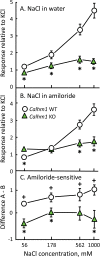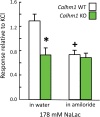Salty taste deficits in CALHM1 knockout mice
- PMID: 24846212
- PMCID: PMC4064958
- DOI: 10.1093/chemse/bju020
Salty taste deficits in CALHM1 knockout mice
Abstract
Genetic ablation of calcium homeostasis modulator 1 (CALHM1), which releases adenosine triphosphate from Type 2 taste cells, severely compromises the behavioral and electrophysiological responses to tastes detected by G protein-coupled receptors, such as sweet and bitter. However, the contribution of CALHM1 to salty taste perception is less clear. Here, we evaluated several salty taste-related phenotypes of CALHM1 knockout (KO) mice and their wild-type (WT) controls: 1) In a conditioned aversion test, CALHM1 WT and KO mice had similar NaCl avoidance thresholds. 2) In two-bottle choice tests, CALHM1 WT mice showed the classic inverted U-shaped NaCl concentration-preference function but CALHM1 KO mice had a blunted peak response. 3) In brief-access tests, CALHM1 KO mice showed less avoidance than did WT mice of high concentrations of NaCl, KCl, NH(4)Cl, and sodium lactate (NaLac). Amiloride further ameliorated the NaCl avoidance of CALHM1 KO mice, so that lick rates to a mixture of 1000 mM NaCl + 10 µM amiloride were statistically indistinguishable from those to water. 4) Relative to WT mice, CALHM1 KO mice had reduced chorda tympani nerve activity elicited by oral application of NaCl, NaLac, and sucrose but normal responses to HCl and NH(4)Cl. Chorda tympani responses to NaCl and NaLac were amiloride sensitive in WT but not KO mice. These results reinforce others demonstrating that multiple transduction pathways make complex, concentration-dependent contributions to salty taste perception. One of these pathways depends on CALHM1 to detect hypertonic NaCl in the mouth and signal the aversive taste of concentrated salt.
Keywords: NaCl; gustatory electrophysiology; salt preference; salt taste.
© The Author 2014. Published by Oxford University Press. All rights reserved. For permissions, please e-mail: journals.permissions@oup.com.
Figures








References
Publication types
MeSH terms
Substances
Grants and funding
LinkOut - more resources
Full Text Sources
Other Literature Sources
Molecular Biology Databases
Research Materials

